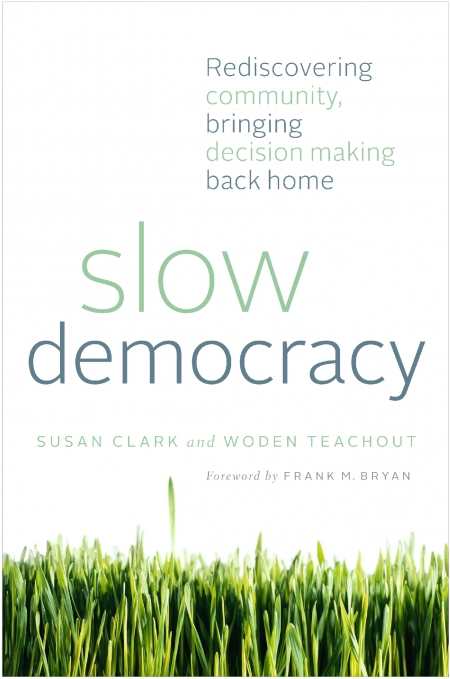Slow Democracy
Rediscovering Community, Bringing Decision Making Back Home
According to a research study released in 2010 by the Pew Research Center for the People and the Press 81 percent of Americans believe that elected officials are more personally ambitious than publicly motivated, while 74 percent rate the federal government’s implementation of its programs as “fair” or “poor.” Additionally, a 2011 New York Times poll found that 89 percent of Americans do not trust the government to do the right thing. As these statistics from Slow Democracy confirm, Americans are dissatisfied with representative government and recognize the decline of democracy in the United States.
Authors Susan Clark and Woden Teachout assert that, “this pervasiveness of negative public sentiment suggests a fundamental shift in the way that individuals relate with their government.” In the nineteenth century, robust public participation and civic action was part of the American character. By contrast, we currently comprise a “discouraged, democratically anemic citizenry,” feeling disempowered and voiceless when it comes to influencing the outcome of public policy issues that affect us, our cities, towns, and neighborhoods.
Nevertheless, there is a way out of this morass—it’s called “slow democracy.” Taking its cue from the slow food movement (a global, grassroots effort that links a way of living and a way of eating with a commitment to community and sustainability), slow democracy encourages democratic decision-making at the local level by members of the community. It forgoes the ideological divisions of left vs. right and promotes self-governance through processes that are inclusive, deliberative, and citizen-powered.
While the notion of wresting power and decision making from the federal level and returning it to citizens and local governments may seem like pie-in-the-sky optimism, activist Clark and historian Teachout cite numerous places where slow democracy is producing results. In New York City; Chicago; Gloucester, Massachusetts; New Orleans; Portsmouth, New Hampshire; and Hacker Valley, West Virginia “painful issues” like racism and crime and “too-hot-to-handle concerns” like budget cuts, school redistricting, environmental protection, and housing are being addressed by ordinary people committed to citizen engagement and collaborative problem-solving.
“When local communities make their own policies,” Clark and Teachout write, “one of the most powerful legacies is not just the political effects of the action, but the sense of democratic possibility that it engenders.” Britt Bailey, an environmental activist involved in a campaign that outlawed the use of genetically engineered crops in Mendocino County, California, attests: “People were ecstatic to find that their involvement in an internationally powerful and controversial issue effected change … it’s [sic] like we the people retrieved our souls.”
Slow Democracy is a user-friendly “blueprint for American redemption.” It inspires the belief that our dwindling democracy can be invigorated. City councilors, town managers, community organizers, politicians, and average Americans will find wisdom in Slow Democracy and will learn strategies to bolster public participation and thus transform our political landscape.
Reviewed by
Amy O'Loughlin
Disclosure: This article is not an endorsement, but a review. The publisher of this book provided free copies of the book and paid a small fee to have their book reviewed by a professional reviewer. Foreword Reviews and Clarion Reviews make no guarantee that the publisher will receive a positive review. Foreword Magazine, Inc. is disclosing this in accordance with the Federal Trade Commission’s 16 CFR, Part 255.

